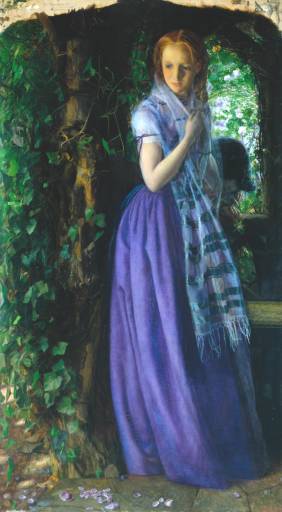“Johnny Lad” is a scottish traditional song with many text versions combined with different melodies.
Johnny Lad (street ballad/ nursery song version)
Jinkin’ You, Johnnie Lad (bothy ballad)
Cock Up Your Beaver (Robert Burns)
Hey how Johnie Lad (Robert Burns)
Och, Hey! Johnnie, Lad (Robert Tannahill)

“Johnny Lad” è una canzone tradizionale scozzese con molte versioni testuali abbinate a diverse melodie.
Och, Hey! Johnnie, Lad
[ Roud V7525 ; Bodleian Roud V7525 ; Robert Tannahill]
In 1806 Robert Tannahill reworked the traditional version of “Hey How Johnny Lad”, a scottish song of courting and abandonment, already reported in “Ancient and Modern Scottish Songs” Vol II (pg 215) by David Herd and in the Scots Musical Museum of Johnson IV, 1792, p. 368 (# 357) presumably from Robert Burns‘s version: the missing date from a suitor otherwise engaged, is traced to a misunderstanding on the place set for the meeting.
“The subject of the song was John Howie, weaver in Paisley (an acquaintance of the Poet), and his sweetheart, Agnes Smith, residing in the Brig o Johnstone district; and was written on the occasion of their having been mistaken in the trysting-place of one of their engagements,—the beau supposing it was the “Thorn,” and the belle the “Wood.”” [1]
Air—“The lassies o the ferry.”
Nel 1806 Robert Tannahill rielabora la versione tradizionale di “Hey How Johnny Lad” una canzone di corteggiamento e di abbandono, già riportata in “Ancient And Modern Scottish Songs” Vol II (pg 215) di David Herd e nello Scots Musical Museum di Johnson IV, 1792, p. 368 (# 357) forse dalla versione di Robert Burns: il mancato appuntamento amoroso da parte di un corteggiatore, in altre faccende affaccendato, viene ricondotto ad un equivoco tra i due sul luogo fissato per l’incontro.
“Il soggetto della canzone era John Howie, tessitore in Paisley (un conoscente del Poeta), e la sua dolce amica, Agnes Smith, residente nel distretto di Brig o Johnstone, e [la canzone] fu scritta in occasione del loro fraintendimento sul luogo dell’appuntamento, – il fidanzato supponendo che fosse al “Thorn,” e la bella al “Wood.”. “ [1]
Chorus
OCH, hey ! Johnnie lad,
Ye’re no sae kind’s ye soud hae been ;
Och, hey ! Johnnie, lad,
Ye didna keep your tryst yestreen :
I waited lang beside the wud,
Sae wae an wearie, a my lane ;
Och, hey ! Johnnie, lad,
Ye’re no sae kind’s ye soud hae been.
I
I lookit by the whinnie knowe (1) ,
I lookit by the firs sae green,
I lookit owre the spunkie howe, (2)]
An aye I thocht ye woud hae been.
The ne’er a supper crost my craig (3),
The ne’er a sleep hae clos’d my een ;
II
Gin ye war waitin by the wud,
Then I was waitin by the Thorn,
I thocht it was the place we set,
An waited maist till dawnin morn ;
Sae be na vext, my bonnie lassie,
Let my waitin stan for thine,
We’ll awa to Craigton shaw (4),
And seek the joys we tint yestreen.
NOTE
1) whinnie= covered with whins and know=a hillock, mound, in folklore often associated with fairies
2) the howe of the spunkie= Will o the Wisp hollow.
3) “The never a supper crossed my throat” craig=neck, the throat, the gullet
4) Craigton shaw could be the Tannahill Craigie-lee grove [2], a place to north-west of Paisley in the Ferguslie Estate or the Craigton grove [3] behind “Johnstone Castle,” a place then famous for making lovers’ vows ”
Traduzione italiana di Cattia Salto
Coro LEI
Accidenti Johnny Lad
Non sei premuroso come dovresti essere
Accidenti Johnny Lad
hai mancato all’appuntamento ieri sera:
ti ho atteso a lungo nel bosco
afflitta e annoiata, tutta sola
Accidenti Johnny Lad
Non sei premuroso come dovresti essere!
I LEI
Ho cercato presso il tumulo roccioso
ho cercato tra gli abeti frondosi
ho cercato nella valle dei fuochi fatui
e sempre pensavo che ti avrei trovato
senza trangugiare cibo
e senza chiudere occhio
II LUI
Se tu attendevi presso il bosco
allora io attendevo al Biancospino
che credevo fosse il posto dell’incontro
e ti attesi fino all’alba;
quindi non essere afflitta, mia bella
che io sono qui davanti a te,
andremo al boschetto di Craigton
e cercheremo le gioie che ieri sera abbiamo perduto
NOTE
(1) i tumuli fatati del folklore celtico
(2) il fenomeno dei fuochi fatui
(3) craig in questo contesto significa collo, gola, esofago
(4) potrebbe essere il boschetto denominato da Tannahill Craigie-lee una località a nord-ovest di Paisley nella Tenuta di Ferguslie [2] oppure il boschetto di Craigton dietro a “Johnstone Castle,—un luogo rinomato per le promesse matrimoniali tra innamorati”
Significativa la presenza del Craigenfeoch (the rock of the ravens) Craigton Woods Carving (Johnstone-Elderslie) una roccia con petroglifo[3]
Emily Smith in The Complete Songs of Robert Tannahill Volume I (2006)
Sam Monaghan in The Tannahill Song Book 2000
[1] http://www.grianpress.com/Tannahill/TANNAHILL’S%20SONGS%2020B.htm
[2] https://terreceltiche.altervista.org/thou-bonnie-wood-o-craigielea/
[3] Craigenfeoch (Craigton Woods Carving (Johnstone-Elderslie)
